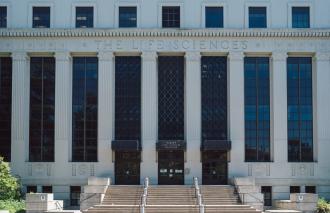UC Berkeley will auction two nonfungible tokens, or NFTs, relating to Nobel Prize-winning inventions for the funding of future research and innovation.
The NFTs being sold include digital art pieces consisting of the original patent disclosure forms behind former campus professor James Allison’s cancer immunotherapy research, for which he shared the 2018 Nobel Prize in physiology or medicine, and CRISPR-Cas9 gene editing, for which campus biochemistry and molecular biology professor Jennifer Doudna shared the 2020 Nobel Prize in chemistry.
NFTs are digital objects printed on a blockchain, or a decentralized and immutable database, that can be owned, according to Rich Lyons, campus’s chief innovation and entrepreneurship officer.
“Nonfungible tokens are digital objects that can be unmistakably and forever owned,” Lyons said. “We’ve tried to create a new category of digital object — one that represents profoundly important science.”
There have never been NFTs representing invention disclosures, according to campus alumna and project contributor Justine Humenansky. She added that the project shows that blockchain and cryptocurrency are more than just “hype” and can be used for incredibly meaningful work.
Lyons appreciated campus leadership supporting the team through critical junctions and said campus never deemed the project too risky.
Campus alumna and project contributor Margaret Valentine said she was also impressed with campus taking advantage of the opportunity.
Humenansky added that auctioning the NFTs will bring awareness and visibility to scientific breakthroughs made on campus in an innovative way.
“Being able to marry Berkeley as a 150-year-old institution with this cutting-edge technology made me really excited,” Valentine said. “And we can use that to fund even more innovation within this space.”
A Berkeley News article noted that 85% of the NFT auction price and 10% of any subsequent sale will go to campus to fund research and offset costs from minting the NFT.
Minting and auctioning the NFT in itself is an innovation that goes beyond research, Lyons noted. He added that the publicity and indirect effects of selling the NFT will outweigh the direct monetary gain.
“Imagine how many more 18 year olds are going to apply to Berkeley because it feels fresh and exciting,” Lyons said. “Imagine how many more grad students will want to come to Berkeley because of the innovation and opportunity.”
The NFTs for auction are the invention and technology disclosures for the inventions and represent the “very first public instantiation” of the scientific discoveries, according to Lyons.
Lyons added that potential buyers will own the digital object “uniquely and forever” unless they decide to resell it, but no intellectual property rights are involved. All relevant patents will stay owned by campus, according to the Berkeley News article.
“The invention disclosures are very meaningful in that they represent some of the most significant breakthroughs of the 21st century,” Humenansky said. “The auction gives people a chance to own a part of history as well as fund really important research.”
Vani Suresh is a research and ideas reporter. Contact her at vsuresh@dailycal.org, and follow her on Twitter at @vanisuresh_.
Correction(s):
Because of misinformation from a source, a previous version of this article incorrectly stated that the NFTs for sale represent intellectual property. In fact, they represent invention disclosures.
